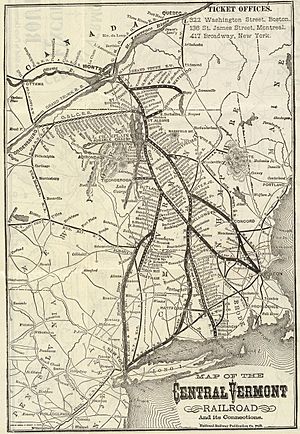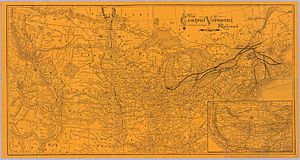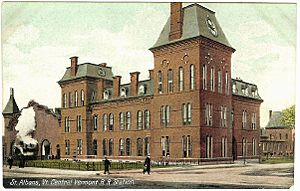Central Vermont Railway facts for kids
| Overview | |
|---|---|
| Reporting mark | CV |
| Locale | Connecticut, Massachusetts, New Hampshire, Vermont, New York, and Quebec |
| Dates of operation | 1848–1995 |
| Successor | New England Central |
| Technical | |
| Track gauge | 4 ft 8 1⁄2 in (1,435 mm) standard gauge |
| Previous gauge | Originally built to 5 ft 6 in (1,676 mm) |
The Central Vermont Railway was a railroad that helped connect many places in the U.S. states of Connecticut, Massachusetts, New Hampshire, New York, and Vermont. It also reached into the Canadian province of Quebec.
This railway was super important! It linked Montreal, Quebec, all the way to New London, Connecticut. Its route went along Lake Champlain, through the Green Mountains, and followed the Connecticut River valley. It also connected Montreal to Boston in Massachusetts, by joining with the Boston and Maine Railroad at White River Junction, Vermont.
Contents
The Story of the Central Vermont Railway
Building the First Lines
The story of this railway began on October 31, 1843. A company called the Vermont Central Railroad was given permission to build a train line. Their plan was to build across the middle of Vermont. This line would go from Burlington (on Lake Champlain) east to Montpelier (the state capital). Then, it would turn southeast and south to Windsor on the Connecticut River.
Building a railway was a huge job! Construction started on December 15, 1845. The first part of the line opened on June 26, 1848. This section went from White River Junction west to Bethel. More sections opened quickly after that. By December 31, 1849, the full line to Burlington was open. A part along the Connecticut River also opened in early 1849.
Expanding the Network
On October 31, 1845, another company, the Vermont and Canada Railroad, was formed. This line was meant to continue the Vermont Central's route north and west. It would go to Rouses Point, New York, passing through St. Albans. The Vermont Central leased this new line in 1849, and it was finished in 1851.
Over the years, the Central Vermont Railway grew a lot. It leased or took over many smaller railway lines. This helped it connect to even more towns and cities. For example, the Montreal and Vermont Junction Railway opened in the 1860s. It extended the line from the Canadian border north to St. Johns, Quebec. This helped connect the railway to the Grand Trunk Railway.
The Central Vermont also gained access to lines that went south. These lines connected it to places like Bellows Falls, Vermont. From there, it could reach Boston through other railways. It also leased the New London Northern Railroad in 1871. This helped connect the railway all the way to New London, Connecticut.
On November 2, 1872, the company officially changed its name to the Central Vermont Railroad.
Challenges and Changes
Like many businesses, the Central Vermont faced tough times. In 1896, the company ran into financial trouble. This meant it needed help to keep running. The Grand Trunk Railway (a much larger railway company) bought the Central Vermont in 1899.
After this, the Central Vermont Railroad was officially reorganized. On May 1, 1899, it became the Central Vermont Railway. Even though it was now owned by Grand Trunk, it kept its own name and identity.
Becoming Part of a Bigger Family
The Grand Trunk Railway itself faced financial problems later on. In 1923, the Canadian government took over the Grand Trunk system. This meant the Central Vermont Railway became part of the Crown corporation Canadian National Railway (CN).
Even as part of CN, the Central Vermont Railway still ran mostly on its own. It was a successful part of the CN network for many years. It carried all sorts of goods, from furniture to milk and farm products.
In the 1950s, new diesel trains started to appear on the Central Vermont lines. The last steam train stopped running in 1957. The 1960s were a bit harder for the railway. Fewer goods were being shipped, and costs were going up.

Over time, the Central Vermont closed down some of its less profitable lines. In the 1990s, the Canadian National Railway decided to sell off some of its parts. The Central Vermont was one of these.
On February 3, 1995, the CN sold the main Central Vermont line. This line went from New London, Connecticut, to East Alburg, Vermont. A company called RailTex bought it and renamed it the New England Central Railroad. This new company continues to operate the railway today.
Important Branches
The Richford Branch
One important part of the Central Vermont system was the Richford Branch. This line started as the Missisquoi Railroad. It later became the Missisquoi Valley Railroad. It was a branch line that went from St. Albans northeast to Richford, Vermont.
This line was used for many years. However, in 1984, a train accident damaged a bridge near Sheldon, Vermont. This made part of the line unusable. Over time, sections of the tracks were removed.
Some of the towns and places this branch served were:
- Saint Albans, Vermont
- Sheldon Springs, Vermont
- Sheldon, Vermont
- Enosburg Falls, Vermont
- Richford, Vermont




